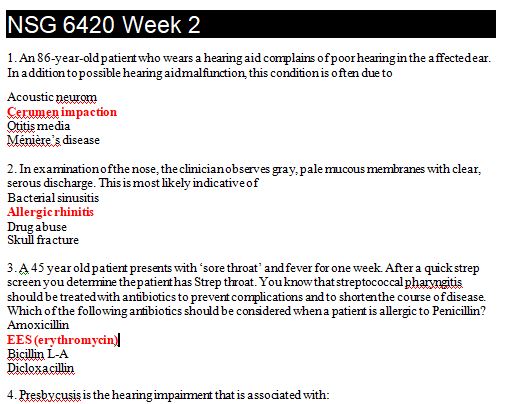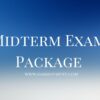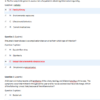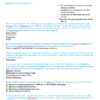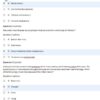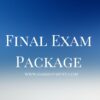Description
NSG 6420 Week 2 Quiz – Question with Answers
- An 86-year-old patient who wears a hearing aid complains of poor hearing in the affected ear. In addition to possible hearing aid malfunction, this condition is often due to
- In examination of the nose, the clinician observes gray, pale mucous membranes with clear, serous discharge. This is most likely indicative of
- A 45 year old patient presents with ‘sore throat’ and fever for one week. After a quick strep screen you determine the patient has Strep throat. You know that streptococcal pharyngitis should be treated with antibiotics to prevent complications and to shorten the course of disease. Which of the following antibiotics should be considered when a patient is allergic to Penicillin?
- Presbycusis is the hearing impairment that is associated with:
- Epistaxis can be a symptom of:
- Your patient has been using chewing tobacco for 10 years. On physical examination, you observe a white ulceration surrounded by erythematous base on the side of his tongue. The clinician should recognize that very often this is
- A 26 year old patient presents with cough and general malaise for 3 days. They note that their eyes have been watering clear fluid and a ‘runny nose’ since yesterday. They note they ‘feel miserable’ and demand something to make them feel better. What would be the best first plan of treatment?
- Which of the following findings should trigger an urgent referral to a cardiologist or neurologist?
- Dizziness that is described as “lightheaded” or, “like I’m going to faint,” is usually caused by inadequate cerebral perfusion and is classified as?
- It is important to not dilate the eye if ____ is suspected.
- Mr. GC presents to the clinic with nausea and vomiting for 2 days, prior to that time he reports occasional ‘dizziness’ that got better with change in position. He denies a recent history of URI or any history of headaches or migraines. What would the most likely diagnosis be?
- Which of the following patients with vertigo would require neurologic imaging?
- A patient presents with eye redness, scant discharge, and a gritty sensation. Your examination reveals the palpable preauricular nodes, which are most likely with
- In assessing the eyes, which of the following is considered a “red flag” finding when associated with eye redness?
- Question 15 of 20 A 64-year-old male presents with erythema of the sclera, tearing, and bilateral pruritus of the eyes. The symptoms occur intermittently throughout the year and he has associated clear nasal discharge. Which of the following is most likely because of the inflammation?
- Patients that have atopic disorders are mediated by the production of Immunoglobulin E (IgE) will have histamine stimulated as an immediate phase response. This release of histamine results in which of the following
- You have a patient complaining of vertigo and want to know what could be the cause. Knowing there are many causes for vertigo, you question the length of time the sensation lasts. She tells you several hours to days and is accompanied by tinnitus and hearing loss. You suspect which of the following conditions?
- In examining the mouth of an older adult with a history of smoking, the nurse practitioner finds a suspicious oral lesion. The patient has been referred for a biopsy to be sent for pathology. Which is the most common oral precancerous lesion?
- Rheumatic heart disease is a complication that can arise from which type of infection?
- A patient complains of fever, fatigue, and pharyngitis. On physical examination there is pronounced cervical lymphadenopathy. Which of the following diagnostic tests should be considered?



